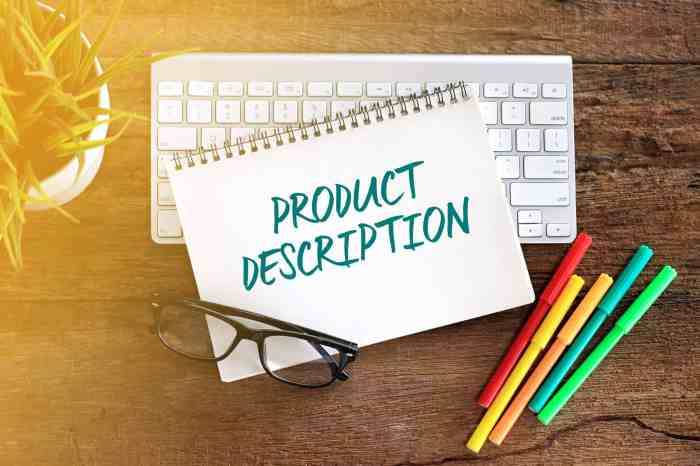Product Descriptions Guide sets the stage for this enthralling narrative, offering readers a glimpse into a story that is rich in detail with an American high school hip style and brimming with originality from the outset.
Get ready to dive into the world of product descriptions, where words can make or break a sale, and creativity is the name of the game.
Introduction to Product Descriptions Guide
In the world of e-commerce, product descriptions play a crucial role in attracting customers and driving sales. A well-crafted product description can make all the difference between a potential customer scrolling past your item or clicking “Add to Cart.”
The Impact of Well-Crafted Product Descriptions
Crafting engaging and informative product descriptions can significantly impact sales by helping customers understand the features, benefits, and unique selling points of a product. A well-written description can create a connection with the customer, instill trust, and ultimately lead to a purchase decision.
- Highlight key features and benefits to showcase the value of the product.
- Use persuasive language to create a sense of urgency or exclusivity.
- Create a story around the product to evoke emotions and create a memorable experience for the customer.
Remember, the goal of a product description is not just to describe the product but to sell the product.
Optimization for Product Descriptions
In the digital age, search engine optimization () plays a crucial role in ensuring your products are visible to potential customers. Optimizing product descriptions with relevant s, meta tags, and structured data can improve your online visibility and attract organic traffic to your e-commerce store.
- Research relevant s related to your product and incorporate them strategically in your description.
- Optimize meta tags such as title tags and meta descriptions to improve search engine rankings.
- Use structured data markup to provide search engines with detailed information about your products.
Components of a Compelling Product Description
When creating a compelling product description, it’s important to include key elements that will engage customers and highlight the unique selling points of the product. This includes features, benefits, specifications, and more. By striking a balance between creativity and informativeness, you can create a product description that not only captures the attention of potential buyers but also provides them with the necessary information to make a purchase decision.
Features and Benefits
- Features: Describe the unique aspects of the product, such as materials used, design elements, and technology.
- Benefits: Explain how these features will benefit the customer, such as saving time, improving efficiency, or enhancing their quality of life.
Specifications
- Specifications: Provide detailed technical information about the product, including dimensions, weight, color options, and any other relevant details.
- Usage: Highlight how the product can be used and any specific instructions for optimal performance.
Example: “Our ultra-lightweight backpack is made from durable nylon material, ensuring long-lasting use (feature). Its ergonomic design reduces strain on your back, making it ideal for long hikes or daily commutes (benefit).”
Writing Style and Tone
When it comes to writing product descriptions, the style and tone you use can greatly impact how your audience perceives your brand and products. It’s important to tailor your writing style to the type of product you are describing, whether it’s technical, fashion, food, or any other category. Additionally, maintaining a consistent tone across all your product descriptions helps establish brand identity and creates a cohesive experience for your customers. Here are some tips on how to adapt your tone to target different audience segments:
Different Writing Styles for Various Products
- For technical products, use a formal and informative tone. Focus on highlighting the features and specifications of the product in a clear and concise manner.
- When writing descriptions for fashion items, consider using a more creative and expressive tone. Describe the style, materials, and overall aesthetic of the product to evoke a sense of style and luxury.
- For food products, aim for a descriptive and sensory tone. Use vivid language to paint a picture of the flavors, textures, and aromas of the food to entice the reader’s taste buds.
Importance of Consistent Tone
Maintaining a consistent tone across all your product descriptions helps build trust with your customers and reinforces your brand’s identity. Whether your brand is casual and friendly or formal and professional, consistency in tone ensures that your messaging is clear and coherent. It also helps create a seamless shopping experience for customers as they navigate through your product offerings.
Adapting Tone for Different Audience Segments, Product Descriptions Guide
- For younger audiences, consider using a more casual and conversational tone to resonate with their preferences.
- When targeting a more mature audience, a sophisticated and authoritative tone may be more effective in establishing credibility.
- If your products cater to a specific niche or community, tailor your tone to align with their values and language to create a sense of belonging and connection.
Formatting and Structure: Product Descriptions Guide

When it comes to structuring product descriptions, it’s important to keep things organized and easy to read. By using headings, bullet points, and formatting techniques like bolding and italicizing, you can enhance the overall readability of your content. Additionally, optimizing your product descriptions for mobile responsiveness ensures that they can be easily scanned on smaller screens.
Using Headings and Bullet Points
Using headings can help break up your product description into different sections, making it easier for readers to navigate and find the information they’re looking for. Bullet points are great for listing out key features or benefits of the product in a concise and easy-to-read format.
- Headings: Use clear and descriptive headings to introduce different sections of your product description.
- Bullet Points: Utilize bullet points to list out important details or features of the product in a scannable format.
Formatting Techniques
Incorporating formatting techniques like bolding and italicizing can help draw attention to important information or key points within your product description. These techniques can help break up the text and make it more visually appealing for readers.
- Bolding: Use bold text to highlight key features, benefits, or important details about the product.
- Italicizing: Italics can be used to emphasize certain words or phrases within the product description.
Optimizing for Mobile Responsiveness
With the increasing use of mobile devices for online shopping, it’s essential to ensure that your product descriptions are optimized for mobile responsiveness. This means keeping paragraphs short and concise, utilizing headers and bullet points for easy scanning, and avoiding large blocks of text that can be overwhelming on smaller screens.
- Short Paragraphs: Break up your product description into shorter paragraphs to make it easier to read on mobile devices.
- Headers and Bullet Points: Use headers and bullet points to organize information and make it more digestible for mobile users.
Visual Elements in Product Descriptions

In today’s digital age, visual elements play a crucial role in enhancing product descriptions and capturing the attention of potential customers. Images, videos, and infographics can help convey information quickly and effectively, making the product more appealing and engaging.
Guidelines for Incorporating Visual Elements
When incorporating visual elements into product descriptions, it is important to strike a balance between text and visuals. Here are some guidelines to help you effectively integrate visual elements without overwhelming the text:
- Choose high-quality images and videos that showcase the product from different angles and perspectives.
- Use infographics to highlight key features, benefits, or specifications in a visually appealing way.
- Ensure that visual elements are relevant to the product and help customers better understand its value.
- Place visual elements strategically throughout the description to break up text and maintain reader interest.
- Optimize images and videos for fast loading times to prevent slow page speeds.
Impact of High-Quality Visuals
High-quality visuals can significantly impact customer engagement and conversion rates. When customers can see clear images or engaging videos of a product, they are more likely to be interested and make a purchase. Visual elements create a more immersive shopping experience, allowing customers to visualize themselves using the product. This can lead to increased trust, improved brand perception, and ultimately higher sales.
